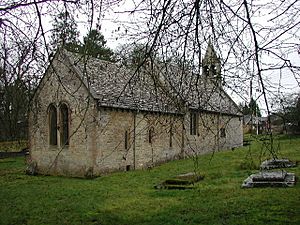Church of St Oswald, Shipton Oliffe facts for kids
Quick facts for kids Church of St Oswald |
|
|---|---|
 |
|
| Lua error in Module:Location_map at line 420: attempt to index field 'wikibase' (a nil value). | |
| Denomination | Church of England |
| Architecture | |
| Heritage designation | Grade I listed building |
| Designated | 26 January 1961 |
| Administration | |
| Benefice | Coln River Group |
| Diocese | Gloucester |
| Province | Canterbury |
The Church of St Oswald is an old church located in Shipton Oliffe, a village in Gloucestershire, England. It was built a very long time ago, in the 12th century (the 1100s). This church is considered a 'Grade I listed building'. This means it's a really important historical building that is protected.
Contents
History of the Church
How Old Is It?
The oldest parts of the Church of St Oswald were built in a style called Norman architecture. This was during the 12th century. Later, in the 13th century (the 1200s), the church was made bigger. New sections like the chancel and a south aisle were added.
Who Owned the Church?
For many years, the church was connected to Gloucester Abbey. This was a large and important religious house in the city of Gloucester.
Updates Over Time
Around the early 1900s, the church had some updates. A west gallery and old-fashioned box pews were taken out. The church was then restored to look its best.
Church Design and Features
What Is It Made Of?
The Church of St Oswald is built from limestone. It has a roof made of stone slates. The church has a main area called the nave, a south transept with a porch, and a chancel.
Bell Tower
There is a small bellcote on the church. It was built in the 13th century. This bellcote has two openings where bells would hang.
Inside the Church
Inside, you can find a medieval font. This is a special basin used for baptisms. It has eight sides. There is also a 14th-century piscina within a sedilia. A piscina is a small basin used for washing sacred vessels. A sedilia is a set of seats, usually for priests.
You can also see small pieces of old wall paintings. These are on the chancel arch and the north wall. The north wall also has a doorway from the Norman period that was later blocked up. A window was put into this space instead.

